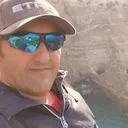Hi, I found this black cup fungus (Ascomycete) and I considered Smardea and Pseudoplectania but now I am fixed on a dark-coloured Peziza sp. This population growing in mossy ground under Pinus halepensis in a forest path, in calcareous soil. In sunlight, the ascocarp has a purplish-brown tinge. I am showing this collection from photos I have taken in the field. Further examination in the Lab follows shortly.
Black Cup-Fungus - Peziza sp.
- Steve_mt
- Erledigt
Es gibt 7 Antworten in diesem Thema, welches 1.516 mal aufgerufen wurde. Der letzte Beitrag () ist von Steve_mt.
-
-
Today I worked on an interesting blackish-brown cup-fungus immersed in mossy calcareous soil in a forest margin (limestone based) here in Ma lta.
- Fruiting bodies 1-2cm wide , blackish-brown, appearing purplish-mauve in sunlight.
- Rim turned inwards, somewhat shallowly warted, without hairs
- Ascii 8-spores, cylindrical and straight, 280-320 un long, J+ve (strongly +ve to Iodine sol.) base bulbous, slightly two-lobed (Croziers?)
- Paraphyses slightly longer than the asci, with slightly swollen tips or sometimes like a golf-club (bent)
- Spores elliptical, thick-walled, with two guttulae, and margin distinctly roughened and reticulate.
Now as it is, it resembles P. badia, but I think this has a little lighter brownish colour and its distribution is northern, and in acidic soils. I wonder if there are vicariants species of P. badia in the Mediterranean region looking like my specimen. P. violaceae maybe ?
P.S. I forgot photos at work - will upload shortly (sorry!)
-
Micro-morphology:
Asci 255-288 um long, 13-15um wide
Spores with two oil bodies, broadly elliptical, with strong ornamentation, sizes:
(13.8) 15.2 - 18.1 (18.4) × (6.7) 7.5 - 9.6 (11.3) err
Q = (1.6) 1.8 - 2.1 (2.3) ; N = 21
Me = 16.6 × 8.8 err ; Qe = 1.9
Medullary excipulum of large globose to slightly angular hyphae, some reaching 50um across!
I think this is Peziza badiofusca
-

Steve_mt
Hat den Titel des Themas von „Pseudoplectania or Smardea ?“ zu „Black Cup-Fungus - Peziza sp.“ geändert. -
Spores at high magnification in Cotton Blue reveal short ridges and big irregular warts which corresponds to Peziza badiofusca. The flesh shows a whitish flesh. I think this is close to the suspected species. Mossy habitat, colour, spore size, ... many characters matching (but not sure if there are other Pezizas to consider!. Pitty I have not dissected a fresh specimen to check for whitish latex, but the cross section of an old specimen shows a bit of white.
-
Hi Steve,
I think the spore length is wrong for P. badiofusca.
I could imagine P. badiofuscoides, but am not sure.
I have not dissected a fresh specimen to check for whitish latex, but the cross section of an old specimen shows a bit of white.
Did you notice a bluish liquid?
Should have both types.
short ridges and big irregular warts
Also for P. saniosa

Greetings
Felli
-
Dear friends. Sorry for my absence but I took a break to spend with my family - although I couldn't take a break from fungi and did some forays near the hotel!
OK back to this peziza, I just read a paper on P. saniosa (Ukranian finding) and I immediately noticed that the ascospores of their findings have very large warts compared to mine. Reading further, I saw that the asci at 360-400 um are much longer compared to my 250-300 um, and the habitat is not the same too. The ascospore length of the Ukrainian P. saniosa is reported to be 15.5-16.2 x 7.5-8.2 um is a bit shorter to that of my samples having sizes about 15.2 - 18.1 × 7.5 - 9.6 um (not sure if they included or excluded the ornamentation).
Saying that, morphologically is a closely related species and I do not have the keys which tell apart these species (maybe these large warts are not significant after all). Unfortunately, I did not injure fresh specimens to check the bluish-latex, but slicing specimens 24-32 hours after collection did not produce latex but the flesh was greyish with a blue tinge. hmmm...
-
Now I am reading about P. badiofuscoides through a paper by Calonge et al. (2009):
P. badiofuscoides is showing a solid match in terms of asci size (reported as 280-300 µm); ascospore size 15-19 x 7-9 um and habitat in damp soil under pine. Being 3-5cm, it is a smaller species from badia ( up to 10cm) and is another feature closer to my findings. However there is one problem - my ascospores have 2 oil bodies (one mentioned for badiofuscoides).
https://www.mycocharentes.fr/pdf1/2116.pdf
However their keys mention 5 other species, sadly noy badiofusca which I eliminated them all except for P. phlebospora. I dont have much info on this species. -
I went to check the population again, same spot, fresh specimens found and injured and dissected, but there was no sap released !!!. I hence assumed we are on the wrong track here with fuscobadia and allies as previously assumed. I did some research and the mossy habitat under Pinus led me to Peziza muscicola which fits very well. It seems to have got a new genus - Lagaliana.
Legaliana muscicola (Donadini) Van Vooren, Ascomycete.org 12 (4): 188 (2020) [MB#835844 ]
MICOLOGIA, di Salvatore Saitta - Peziza muscicola - Galleria fotografica


